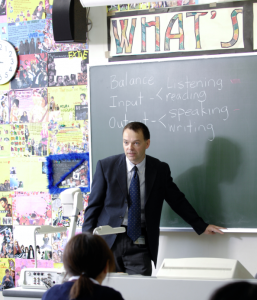In my bag there’s always a small fabric ball. As I begin working with a new class, I take it out and casually toss it from hand to hand. Then, as I ask a question, I make eye contact with someone, toss the ball to him or her, and softly clap my hands. It’s obvious to everyone in the room that the person with the ball is meant to say something. Of course I encourage that something and help as needed. Then, I respond to what’s been said and depending on what’s been said, clap my hands softly again and either gesture that I’d like the ball back or that I’d like it passed on to someone else.
When I take the ball back myself it means that I’d like to clarify something or build on what’s been said. If I then set the ball down, walk over to the board and begin to write something, it means we’re going to do a little language work that I want people to take note of and build into their responses. If after tossing the ball back, I move to the back of the room, it means they’re on their own and need to direct their own flow for a while. If I walk to the front of the room and ask for the ball back, it means we’re changing activities. It doesn’t take long for everyone to get into the rhythm of this. The ball, the handclap, the way I move and the rather dramatic way I use my eyes make it seem like some kind of game. It’s not. It’s a playful structure.
Along the way, I model little strategies like saying the name of the person I’m going to toss the ball to with rising intonation; like saying uh huh when someone says Chuck? before tossing me the ball; like saying hmmm, let me think about that a moment before replying. All the while, my movements in class become a pattern everyone understands.
By the second or third class meeting, the ball becomes an unnecessary prop and all I need is the eye contact and the handclap. By the fourth class, the handclap becomes unnecessary and then all that’s needed is the eye contact. By the fifth class, I can let go of my ritualized movement. The structure is still there, though, but it’s now invisible.
My eyes say it all and it’s at this point that I can then step back.
Still, if things ever get out of hand, I can pull the ball out, clap my hands, and use my movements again to remind people of the structure without ever saying a word about it. If things get really out of hand, someone in the room is likely to get the Chuck look which by this time everyone knows means “you’d better get back on task and stop doing what it is you’re doing.” I never need to verbally chastise anyone. My eyes do it, but then of course, the Chuck look is followed by my smile to let everyone know that it’s all really okay and it always is.
While you may feel uncomfortable with the ball, the handclap, the dramatic looks and the ritualized movement that I use, what I recommend is that you find a structure that works for you, build it up and then dismantle it step-by-step until only the memory of it remains. Whether it’s a class of 20 or a class of 100, doing this before you unplug and step back to just let learning happen will help tremendously.










 Barbara Sakamoto
Barbara Sakamoto